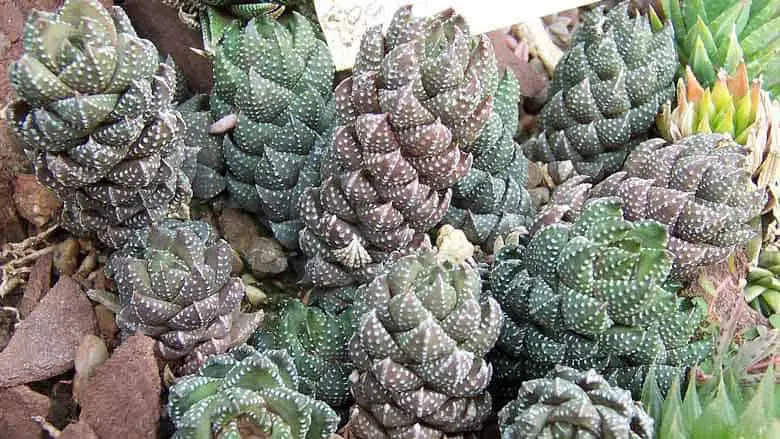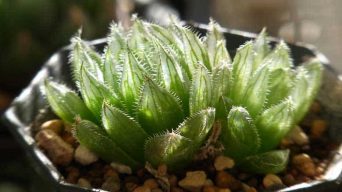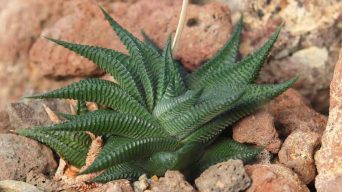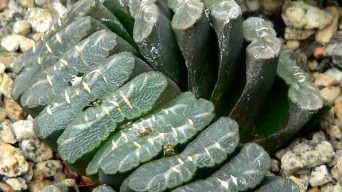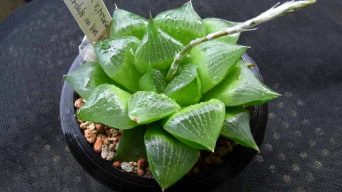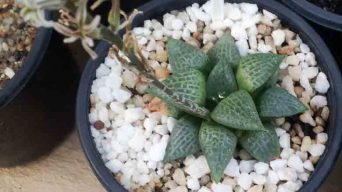The Haworthia coarctata plant is a beautiful, low-maintenance succulent with thick leaves and stems covered in shiny, white bumps.
It hails from the Eastern Cape Province of South Africa, where it grows on rocky slopes.
This guide will teach you everything you need to know about Haworthia coarctata care and propagation!
Overview
The Haworthia coarctata plant originates from Cape Province, South Africa, and is found in the low-lying rainfall area of Table Mountain.
Haworthia coarctata is a plant from the Asphodelaceae family, and the genus has had its classification updated to haworthiopsis. Although most people still call it “haworthia”.
The Haworthiopsis coarctata is a slow-growing, clumping succulent species that typically reach 8 inches (20 cm) in height. It produces rosettes of thick dark green leaves with white spots and stripes.
Haworthia coarctata plants produce flower stalks of up to 12 inches (30 cm) that grow from late spring through fall.
The flowers of this Haworthia species are white and bell-shaped with six to eight petals.
How To Care for Haworthia Coarctata Succulents
The Haworthia coarctata requires very little care and can live for years without much attention at all.
However, it’s also important not to neglect their needs completely! If taken proper care of, they do well indoors and outdoors.
Sun Exposure & Light Requirements
Haworthia coarctata thrive best in full to partial sun.
These succulents are haworthias that grow naturally in very sunny areas.
They need plenty of sunlight to thrive and should ideally get at least six hours. Still, it is advisable to avoid direct afternoon sunlight.
Exposure to morning sun is advised as it will not cause the plant to get sunburned.
If you live in a hot climate, it is advised that Haworthia coarctata plants be placed in the shade during midday hours for their best health and growth.
Haworthias prefer bright sunlight, which is why the windowsills of most homes make great places to grow Haworthias.
They’ll get plenty of light during the day while also getting shelter from direct sun exposure during the hottest hours of the daytime.
Watering Requirements
Only water Haworthia coarctata succulents when the top inch or so of soil is dry.
The plant should never sit in a pool of its own wetness, and watering it too often can cause root rot.
You can tell whether Haworthia coarctata needs to be watered by touching it gently with your finger. If the leaves feel crispy, they need more moisture; if they’re soft or bendy, you don’t need to do anything just yet.
To water the Haworthia coarctata succulent, pour about an inch of water over its soil and wait until it drains.
If the leaves of your haworthia coarctata begin to droop, then it needs water.
The Haworthia coarctata succulent should be watered about once a week.
Haworthias are known for their drought tolerance and usually do just fine if you forget to water them occasionally.
But it’s always best to give these plants as much moisture as they need so that they can thrive in your home.
Soil Requirements
Haworthia coarctata plants prefer very well-draining soil that does not hold water.
The Haworthia succulent plant will rot if it has too much moisture or water in the soil, so make sure to use an appropriate type of cactus/succulent mix!
The Haworthia plant should be grown in a potting mix that is sandy or gritty, and this soil must drain quickly to prevent the Haworthia succulent from rotting!
If you do not have an appropriate type of cactus/succulent mix, use potting soil with more sand and perlite added for better drainage.
The Haworthia coarctata requires a well-draining, fast-draining substrate if it’s going to grow successfully indoors!
Temperature and Humidity
Haworthia coarctata can tolerate a wide range of temperature and humidity levels, from temperatures as low as 32°F (0°C) to 75°F (24°C).
However, Haworthia Coarctata prefers average indoor conditions of around 65-70 degrees Fahrenheit.
Haworthia coarctata prefers a lower humidity and can tolerate up to 60%. If the relative humidity is too high, it may result in leaves losing their turgor.
The best way to measure the humidity levels of your Haworthia coarctata plant is with a hygrometer (a device that measures moisture).
Ideally, you should aim for 30-50% relative humidity to keep Haworthias healthy.
If you are having trouble maintaining this level, consider getting an oscillating fan or humidifier so that water evaporates quicker from plants’ leaves.
Fertilizing
Fertilizing Haworthia coarctata succulents is not necessary, but you can do it if you want.
Fertilize Haworthia succulents when they are dormant or even right after new offsets have formed and grown to about the size of a dime.
Use an organic houseplant fertilizer at half strength to ensure that your plant doesn’t get any unwanted chemicals on its succulent leaves while feeding them nutrients.
Potting and Repotting
Repotting the Haworthia succulent is necessary when the plant has outgrown its container or if it is rootbound.
It’s important not to wait too long and allow new roots to grow around the outside edge of the pot – this can lead to a top-heavy Haworthia, which may topple over.
Plant pots should be at least one inch wider than their current width and depth for optimum success.
Ensure there are drainage holes in both the bottom of your Haworthia’s old container and on all sides of your new planting area.
Pruning haworthia coarctata
The Haworthia coarctata does not need to be pruned.
If you choose to prune haworthia coarctata, remove dead leaves or flowers with sharp, clean scissors. Make sure to cut above the leaf node, which is where the roots are located.
This will prevent disease and allow for more light to reach through the foliage of your Haworthias plant.
Pests and Diseases
Haworthia coarctata succulents are not prone to pests and diseases. However, it is still important to be on the lookout for any of these problems so they can be dealt with quickly.
Mealybugs
These are a type of plant louse that feeds on the sap and juices from another plant.
To get rid of mealybugs, use an alcohol solution or insecticidal soap to kill them before removing them by hand or with cotton swabs dipped in rubbing alcohol.
Root Rot
This is caused when soil becomes too wet for extended periods, leading to root suffocation.
To avoid this problem, make sure Haworthia coarctata succulents receive adequate drainage and plenty of light so they can dry out quickly rather than wilt because their roots are submerged in water.
Fungal Diseases
Fungi will often attack Haworthia coarctata succulent during periods of high humidity and low air circulation.
To prevent this, keep haworthia coarctata plants in an area with plenty of light and space between them to promote better airflow so they can dry out more quickly.
Scale
These insects look like brown or tan bumps on the Haworthia coarctata with fleshy leaves or stem.
Scale bugs suck up nutrients from plants while they are feeding. They leave yellow spots and stunted growth on the leaves below.
The most effective method for eliminating scale involves scraping it off using either your fingernail or a cotton swab soaked in rubbing alcohol.
How to Care for Haworthia Coarctata in Winter
Haworthia plants are not frost-hardy but tolerate a little cold weather.
You should keep haworthias in a pot that can be removed and taken indoors for the winter.
Place haworthias in a bright window to ensure that they get enough light and keep the soil moist.
Water haworthia plants sparingly in winter, so the soil is just damp. Due to fewer daylight hours and cooler temperatures, the succulent leaves will turn yellow or brown if overwatered during this time of year.
If you live in an area with cold winters, try planting haworthias inside for the winter months.
A south-facing windowsill is ideal but not always possible (especially for those living in apartments).
You can also plant haworthias outside before it gets too cold and bring them back inside when frost threatens your garden areas.
How To Propagate Haworthia Coarctata
Haworthia coarctata is a relatively easy succulent to propagate. Offsets, seeds, and leaves can propagate it.
Offsets
In general, the best method for propagating Haworthias is by removing offsets. Offsets are the small Haworthia plantlets that grow on the side of the parent plants and eventually fall off when they reach maturity.
These can be removed with your hands or pliers, but you should always use gloves to not leave any chemical residue from touching oils on both leaves and petioles (the stem).
Once you’ve detached an offset, gently remove its protective sheath using your fingers or pliers. If it’s still attached at one end, make sure it has been loosened before trying again: this will prevent damaging the plantlet.
Place the offset on a well-drained, exposed soil surface with plenty of sun or grow lights, and keep it watered for about one month until you see new growth.
Haworthia offsets will typically start producing their own leaves around this time, so once they are established in the potting media, stop watering them altogether for optimal results.
Once root development is complete, transplant your plant into its final home, where it can continue to thrive and produce more offsets!
Seeds
Another way to propagate haworthia coarctata is through the use of seeds.
To plant a haworthia seed:
- Place it on top of well-drained potting media that has been soaked with water for about two hours prior.
- Be sure not to cover the seed when you set it down, and gently pat it into place to avoid damaging it.
- Keep your haworthias watered regularly but make sure they don’t become too wet.
New offsets should start popping up around the mother plant in about six weeks! As these mature, separate them like before so that the haworthia coarctata plant can continue to spread and multiply.
Leaves
Haworthia coarctata can also be propagated from leaves.
To do this, remove a healthy leaf in its entirety from the haworthia coarctata, being sure to remove any attached petioles and rinse it with water.
Allow the leaf cutting to callous for a few days until a brown crust appears before planting it in moist, well-drained soil with plenty of sun or grow lights.
New Haworthia coarctata plants should be popping up in about three months and ready to go!
Be sure not to overwater the Haworthias that have been propagated from leaves: this will result in mold growth which can kill your plantlets if left unchecked.
Is Haworthia coarctata Toxic?
Haworthia coarctata is not toxic to humans and animals.
However, it is always advisable to exercise caution as with any other plant.
When handling haworthias, always wear appropriate gloves since their sap may cause irritation on bare skin.
Mostly, the toxicity of Haworthia coarctata comes from its sap, which is irritating, and can bring about allergic reactions on contact with skin or eyes.
Final Thoughts
Haworthia coarctata care is quite simple. These plants are great for beginner gardeners because they require very little attention to thrive.
This succulent makes an excellent houseplant. Its small size makes it easy to grow indoors successfully in containers without using much space on the windowsill or other areas.

